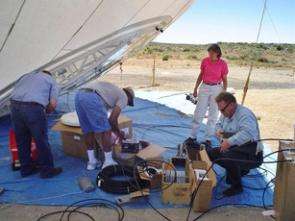'Paint-On’ Antenna Test Flight Paves Way for Next-Generation High-Altitude Airships

"Paint-on" antennas, designed to establish new high-altitude communications and surveillance platforms, successfully transmitted voice and data links as well as teleconferencing capabilities during test flights in the Nevada desert June 21 on board a SA-60 spherical airship.
RTI International and its research partners at Unitech, Applied EM, the International Communications Group, and TechSphere Systems International, a wholly owned subsidiary of Cyber Defense Systems, successfully tested the antennas from several positions on the airship. The experiment provided the first opportunity to test and evaluate the electrical, electromagnetic and mechanical properties of the "paint-on" antenna technology during an actual flight.
“The successful airship test flights demonstrate exciting possibilities for ‘paint-on’ antenna technologies,” said David Myers, vice president of RTI’s Engineering and Technology Unit. “This new technology can be used to assist with hurricane disaster relief, provide enhanced security of ports and borders, perform science observation missions and improve military communications.”
High altitude airships can be used for both defense and homeland security purposes including surveillance of battlefields and domestic borders and ports. The airships are intended to serve as economical station-keeping communications and/or ground-sensing platforms that will augment both ground-based and more expensive satellite systems. The airships will operate well above commercial air traffic and the jet stream and beyond the range of most ground-to-air missiles.
In addition to communications, the “paint-on” antennas are a key enabling technology to achieve the high altitudes necessary for Department of Defense and Homeland Security persistent surveillance missions of the nation's coastal waters, land borders, urban areas and critical infrastructure.
The RTI team designed and tested the “paint-on” antennas funded in part with internal research and development resources and then teamed up with Applied EM and Unitech, two companies that are developing related technology under an Air Force Small Business Innovative Research Program. Applied EM specializes in antenna design, development and electromagnetic simulations; Unitech has patented water-based conductive coating called Unishield™ suitable for "paint-on" antenna development.
RTI's other research partners include TechSphere Systems International, a company that worked with 21st Century Airships to develop a new airship concept for achieving the high altitudes required of the system, and the International Communications Group (ICG), a global communications company recognized for its expertise with the Iridium Satellite communications.
Through its long-standing relationship with the National Aeronautics and Space Administration’s (NASA), RTI also arranged for NASA to demonstrate the potential of a lower-cost alternative to satellite remote sensing by installing a GPS Reflectance Remote Sensing Experiment to conduct soil moisture measurements during the flight. An accurate map of soil moisture would provide information for agriculture efficiency, water management and disaster planning.
The test flight was conducted on a spherical airship designed using Sierra Nevada and TechSphere technology.
Source: RTI International





















